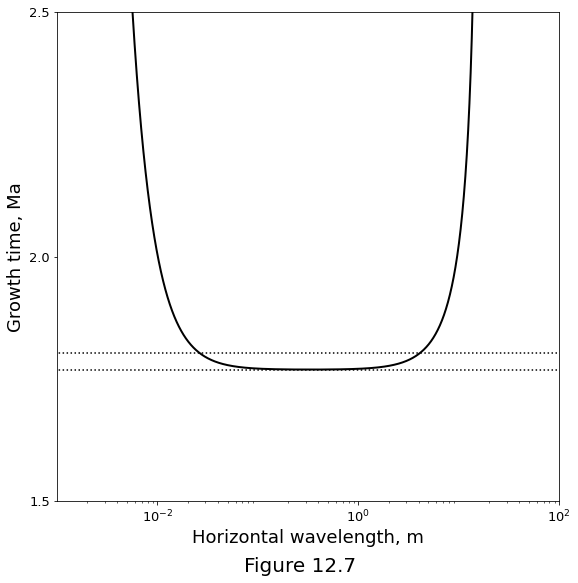Chapter 12 - Reactive flow and the emergence of melt channels¶
%matplotlib inline
import matplotlib.pyplot as plt
from matplotlib import gridspec
import numpy as np
from scipy.optimize import fsolve
from scipy.linalg import det, lstsq
from cycler import cycler
import warnings
warnings.filterwarnings('ignore')
Linearised stability analysis¶
The base state¶
The assembled, base-state solution is given by
The base-state solutions \(\eqref{eq:rxflow-base-state-solution_1}\)-\(\eqref{eq:rxflow-base-state-solution_4}\) are plotted in Figure 12.2 below for two values of \(\rpro\). Thick lines are the full solution and narrow lines are the linear approximation. In each case, \(\stiff=1\), \(\dpro=1\) and \(\permexp=3\). The values of \(\por\zeroth\) (panel (c)) and \(w\zeroth\) (panel (d)) at \(z=0\) are given by \(\cbasestate^{-1}\) and \(\cbasestate\), respectively.
n = 3.0
G = 1.0
M = np.asarray([0.01, 0.1])
S = 1.0
H = 1.0
z = np.linspace(0.0, H, 1000)
F = np.power([1.0 + S*m*(1+G) for m in M], 1/n)
chi = np.asarray([(1.+G)*np.exp(m*z) - G for m in M])
cmp = -(chi + G)
phi = np.power(
[chij/(1.0 - S*m*cmpj) for chij, m, cmpj in zip(chi, M, cmp)],
1.0/n
)
w = chi/phi
cmpl = -(1.0+G) * np.asarray([1.0 + m*z for m in M])
chil = 1.0 + np.asarray([m*(1+G)*z for m in M])
phil = np.asarray(
[1.0/Fj * (1.0 + m*(1.0 + G)/n*z) for Fj, m in zip(F, M)]
)
wl = np.asarray(
[Fj*(1.0 + m*(1.0+G)*(1.0-1.0/n)*z) for Fj, m in zip(F, M)]
)
f, ax = plt.subplots(1, 4)
f.set_size_inches(15., 9.)
plt.rc(
'axes',
prop_cycle=(
cycler(color=['k', 'k', 'k', 'k'])
+ cycler(linestyle=['-', '--', ':', '-.'])
)
)
lines = ax[0].plot(chi.transpose(), z, linewidth=2.0)
ax[0].set_xlabel(r'$\chi^{(0)}$', fontsize=18)
ax[0].set_xlim(0.0, 1.3)
ax[0].set_xticks((0.0, 0.5, 1.0))
ax[0].set_ylabel('$z$', fontsize=18)
ax[0].set_ylim(0.0, 1.0)
ax[0].tick_params(axis='both', which='major', labelsize=13)
ax[0].text(
0.02, 0.01, '(a)', fontsize=18,
verticalalignment='bottom', horizontalalignment='left'
)
plt.legend(
handles=(lines[0], lines[1]),
labels=(
r'$\mathcal{M}=0.01\,(\mathcal{F}\approx1.007)$',
r'$\mathcal{M}=0.1\,(\mathcal{F}\approx1.06)$'
),
fontsize=15, bbox_to_anchor=(-2.5, 1.02, 2.5, .2),
loc='lower right', ncol=2, mode="expand", borderaxespad=0.
)
ax[1].plot(cmp.transpose(), z, linewidth=2.0)
ax[1].plot(cmpl.transpose(), z, linewidth=0.5)
ax[1].set_xlabel(r'$\mathcal{P}^{(0)}$', fontsize=18)
ax[1].set_xlim(-2.3, 0.0)
ax[1].set_xticks((-2.0, -1.0, 0.0))
ax[1].set_yticks(())
ax[1].set_ylim(0.0, 1.0)
ax[1].tick_params(axis='both', which='major', labelsize=13)
ax[1].text(
-0.35, 0.01, '(b)', fontsize=18,
verticalalignment='bottom', horizontalalignment='left'
)
ax[2].plot(phi.transpose(), z, linewidth=2)
ax[2].plot(phil.transpose(), z, linewidth=0.5)
ax[2].set_yticks(())
ax[2].set_xlabel(r'$\phi^{(0)}$', fontsize=18)
ax[2].set_xlim(0.0, 1.1)
ax[2].set_xticks((0.0, 0.5, 1.0))
ax[2].set_ylim(0.0, 1.0)
ax[2].tick_params(axis='both', which='major', labelsize=13)
ax[2].text(
0.02, 0.01, '(c)', fontsize=18,
verticalalignment='bottom', horizontalalignment='left'
)
ax[3].plot(w.transpose(), z, linewidth=2)
ax[3].plot(wl.transpose(), z, linewidth=0.5)
ax[3].set_xlabel(r'$w^{(0)}$', fontsize=18)
ax[3].set_yticks(())
ax[3].set_xlim(0.0, 1.3)
ax[3].set_ylim(0.0, 1.0)
ax[3].set_xticks((0.0, 0.5, 1.0))
ax[3].tick_params(axis='both', which='major', labelsize=13)
ax[3].text(
0.02, 0.01, '(d)', fontsize=18,
verticalalignment='bottom', horizontalalignment='left'
)
f.supxlabel("Figure 12.2", fontsize=20)
plt.show()
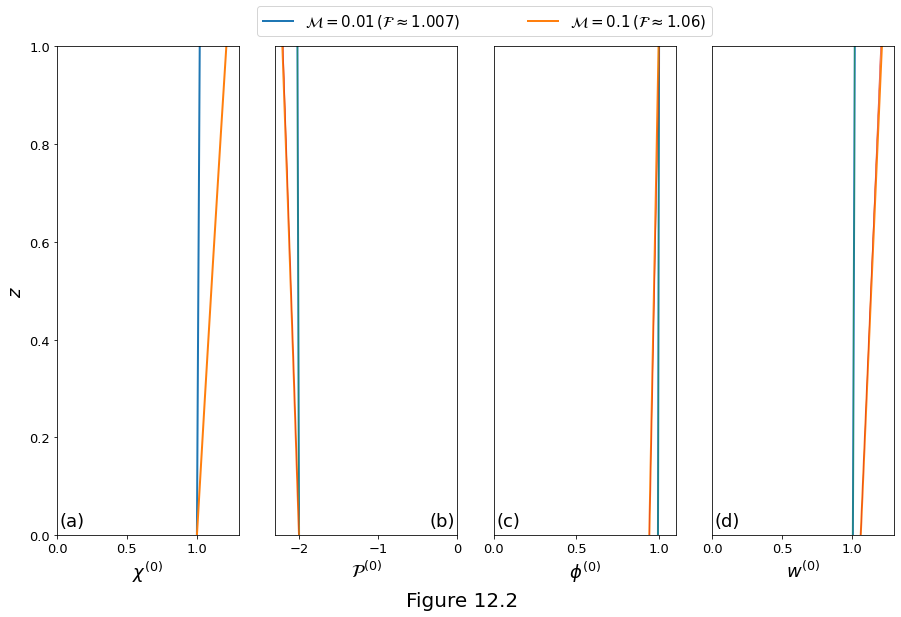
The growth rate of perturbations¶
The perturbation to the base-state compaction pressure is an ansatz with unknown \(k,m_j,\sigma\), constructed from eigenfunctions of the differential operators, given by
where \(\text{Re}\) means taking only the real part of the complex expression. Equation \(\eqref{eq:rxflow-cbs-ansatz}\) satisfies a linear, partial differential equation that is third order in the \(z\) direction
class PAR:
def __init__(
self, F_=1.0, n_=3, S_=1.0, Da_=1000.0, Pe_=100.0, M_=0.01, G_=1,
bc_=2, nz_=2000, tol_=1e-5, plot_=False, step_=0.01, largeDa_=False
):
self.F = F_ # base - state parameter - force to be constant
self.n = n_ # permeability exponent
self.S = S_ # rigidity parameter
self.Da = Da_ # Damkohler number
self.Pe = Pe_ # Peclet number
self.M = M_ # solubility gradient parameter
self.G = G_ # decompression melting parameter
self.bc_type = bc_ # boundary condition type -- 1) P(1)=0; 2) P'(1)=0
self.nz = nz_ # number of points for eigenfunction
self.tol = tol_ # tolerance
self.plot = plot_ # plot eigenfunction
self.step = step_ # stepsize in log10(k) - sigma space
self.largeDa = largeDa_
class EIG:
def __init__(self, p_=0.0, phi_=0.0):
self.P = p_
self.phi = phi_
class SA:
def __init__(self, k_=0.0, sigma_=0.0, m_=0.0, flag_=False):
self.k = k_
self.sigma = sigma_
self.m = m_
self.eig = EIG()
self.flag = flag_
class DC:
def __init__(self, s_=0.0, k_=0.0, m_=0.0):
self.s = s_
self.k = k_
self.m = m_
Substituting \(\eqref{eq:rxflow-cbs-ansatz}\) into \(\eqref{eq:rxflow-cbs-por}\) we obtain the characteristic polynomial
where \(\Kk = 1 + k^2/\left(\Da\Pe\right)\). For a given value of \(\sigma\) (which is, in fact, an unknown), equation \(\eqref{eq:characteristic-poly-cbs}\) is solved to obtain the roots \(m_j\).
The function characteristic_polynomial below evaluates the coefficients of the characteristic polynomial.
def characteristic_polynomial(k, sig, par):
k2 = k[0] * k[0] if type(k) is np.ndarray else k * k
K_ = k2 / par.Da / par.Pe / par.F + 1.0
# cubic
p3 = 0.0 if par.largeDa else sig / par.Da
# quadratic
p2 = sig * K_ - par.n * np.power(
par.F, 1 + par.n
) / par.Da / par.S
# linear
p1 = -(
par.n * np.power(
par.F, 1 + par.n
) * K_ / par.S + sig * k2 / par.Da
)
# constant
p0 = k2 * (par.n * np.power(par.F, 1 - par.n) - sig * K_)
p = np.array([p3, p2, p1, p0])
return p.reshape(p.shape[0])
The boundary conditions impose zero perturbation of the base-state along the bottom boundary. Hence we take \(\usat\first=\por\first=w\first=0\) at \(z=0\). Moreover, we require that perturbations to the flow are unimpeded (and unforced) by gradients in the compaction pressure at the top of the domain, \(z=1\). Using these boundary conditions and equations \(\eqref{eq:rxflow-base-state-solution_1}\)-\(\eqref{eq:rxflow-base-state-solution_4}\) we find that
This set of conditions must hold for all \(x\) and \(t>0\). Combining these conditions with our ansatz \(\eqref{eq:rxflow-cbs-ansatz}\) and expressing in terms of a matrix-vector multiplication gives
The Python function boundary_condition_matrix implements the system of equations \(\eqref{eq:rxflow_cbs_matrix_eqn}\).
def boundary_condition_matrix(k, m, sig, par):
if par.bc_type == 1:
M = np.array(
[[1.0, mi, np.exp(mi)] for mi in m]
).transpose()
elif par.bc_type == 2:
M = np.array(
[[1.0, mi, mi * np.exp(mi)] for mi in m]
).transpose()
elif par.bc_type == 3:
q = sig * par.S / par.n
M = np.array([[
q * mi - 1.0,
q * mi * mi - mi - q * k ** 2,
mi * np.exp(mi)
] for mi in m]).transpose()
else:
q = k * k * par.Da / par.DaPe
M = np.array(
[[1.0 - par.S * mi,
mi * mi + q * mi,
mi * np.exp(mi)]
for mi in m]
).transpose()
return M
def zero_by_sigma_or_wavenumber(sig, k, par):
m = np.roots(characteristic_polynomial(k, sig, par))
if par.largeDa:
residual = np.real(m[0]) * np.sin(np.imag(m[0])) + \
np.imag(m[0]) * np.cos(np.imag(m[0]))
else:
detM = det(boundary_condition_matrix(k, m, sig, par))
residual = np.real((1. - 1.j) * detM)
return residual
def form_eigenfunction(k, sigma, par):
m = np.roots(characteristic_polynomial(k, sigma, par))
z = np.linspace(0.0, 1.0, par.nz)
eig = EIG()
if par.largeDa:
eig.P = np.exp(np.real(m[0]) * z) * np.sin(np.imag(m[0]) * z)
eig.P = eig.P / np.max(np.abs(eig.P))
Q = (m[0] ** 2 - k ** 2) * eig.P
eig.phi = np.power(par.F, -1.0 - par.n) * \
par.S / par.n * np.cumsum(Q) * (z[1] - z[0])
else:
M = boundary_condition_matrix(k, m, sigma, par)
subM = M[:, 1:]
b = -M[:, 0]
A = (1.+0.j) * np.ones(3)
A[1:] = lstsq(subM, b)[0]
eig.P = np.zeros_like(z, dtype=np.complex128)
Q = np.zeros_like(z, dtype=np.complex128)
for Aj, mj in zip(A, m):
tmp = Aj * np.exp(mj * z)
eig.P += tmp
Q += (mj * mj - k * k) * tmp
eig.phi = np.power(par.F, -1 - par.n) * \
par.S / par.n * np.cumsum(Q) * (z[1] - z[0])
return eig
Function reactive_flow_solve_dispersion below implements a recipe for obtaining solutions: for a given set of parameters \(\permexp\), \(\stiff\), \(\Da\), \(\Pe\) and a chosen horizontal wavenumber \(k\), form an initial guess of \(\sigma\). Using this guess, obtain the three roots of the characteristic polynomial \(\eqref{eq:characteristic-poly-cbs}\). Use these roots to form the residual \(r\). If \(r\) is below a specified tolerance, accept the guess of \(\sigma\) as a solution; otherwise, improve the guess of \(\sigma\) (using, for example, \(\infd r/\infd\sigma\) and Newton’s method) and again form the residual. Repeat this until the tolerance has been satisfied. Then, with the converged value for \(\sigma\), obtain the roots \(m_j\), take \(A_1=1\), and solve the system of equations \(\eqref{eq:rxflow_cbs_matrix_eqn}\) for \(A_2\) and \(A_3\). Use the values of \(A_j\) to form the eigenfunction \(\cmppres\first\) at \(t=0\).
def reactive_flow_solve_dispersion(k_guess, sigma_guess, par, verbose=False):
sa = SA()
if type(k_guess) is not np.ndarray:
# solving for growthrate sigma at a fixed value of wavenumber k
solve_for_sigma = True
sa.k = k_guess
if sigma_guess is None:
sigma_guess = np.logspace(-1.0, 1.0, 100)
if type(sigma_guess) is not np.ndarray:
sigma_guess = np.asarray([sigma_guess])
else:
# solving for wavenumber k at a fixed value of growthrate sigma
solve_for_sigma = False
if type(sigma_guess) is not np.ndarray:
sa.sigma = sigma_guess
else:
sa.sigma = sigma_guess[0]
if par.F is None:
par.F = np.power(1.0 + par.S * par.M * (1.0 + par.G), 1.0 / par.n)
sigma = np.zeros_like(sigma_guess)
k = np.zeros_like(k_guess)
if solve_for_sigma:
# solve eigenvalue problem to find growth rate of fastest-growing mode
res = np.zeros_like(sigma_guess)
exitflag = np.zeros_like(sigma_guess)
converged = np.zeros_like(sigma_guess)
problem_sigma = lambda s: zero_by_sigma_or_wavenumber(s, sa.k, par)
for j in range(len(sigma_guess)):
[sigma[j], infodict, exitflag[j], _] = fsolve(
problem_sigma, sigma_guess[j], full_output=True, xtol=1.e-14
)
res[j] = infodict["fvec"]
converged[j] = exitflag[j] == 1 and np.abs(res[j]) < par.tol
if par.largeDa:
m = np.roots(
characteristic_polynomial(sa.k, sigma[j], par)
)
converged[j] = \
converged[j] and np.pi / 2 < np.abs(np.imag(m[0])) < np.pi
if par.plot and converged[j] == 1:
eig = form_eigenfunction(sa.k, sigma[j], par)
else:
# solve eigenvalue problem to find wavenumber of mode
problem_wavenumber = lambda s: zero_by_sigma_or_wavenumber(sa.sigma, s, par)
res = np.zeros_like(k_guess)
exitflag = np.zeros_like(k_guess)
converged = np.zeros_like(k_guess)
for j in range(len(k_guess)):
[k[j], infodict, exitflag[j], _] = fsolve(
problem_wavenumber, k_guess[j], full_output=True, xtol=1.e-14
)
res[j] = infodict["fvec"]
converged[j] = exitflag[j] == 1 or abs(res[j]) < par.tol
if par.largeDa:
m = np.roots(characteristic_polynomial(k[j], sa.sigma, par))
converged[j] = \
converged[j] and np.pi / 2 < np.abs(np.imag(m[0])) < np.pi
if par.plot and converged[j] == 1:
eig = form_eigenfunction(k[j], sa.sigma, par)
plt.plot(np.linspace(0.0, 1.0, par.nz), np.real(eig.P))
none_converged = not np.sum(converged)
# handle failure to find solution
if none_converged:
if verbose:
print(f'FAILURE: no solution found for k={k_guess}')
sa.sigma = np.nan
sa.k = np.nan
sa.m = [np.nan, np.nan, np.nan]
sa.eig.P = np.nan
sa.flag = False
return sa
elif solve_for_sigma:
sa.sigma = np.amax(sigma[converged != 0])
else:
sa.k = np.amax(k[converged != 0])
sa.m = np.roots(characteristic_polynomial(sa.k, sa.sigma, par))
# form and check eigenfunction
sa.eig = form_eigenfunction(sa.k, sa.sigma, par)
gP = np.gradient(sa.eig.P)
if (gP < 0).any() and par.bc_type != 1:
sa.flag = False
if verbose:
print(
'FAILURE: non-monotonic eigenfunction ' +
f' for k={sa.k}, sigma={sa.sigma}'
)
else:
sa.flag = True
if verbose:
print(
'SUCCESS: monotonic eigenfunction ' +
f' for k={sa.k}, sigma={sa.sigma}'
)
if par.plot:
plt.plot(
np.linspace(0, 1, par.nz), np.real(sa.eig.P), linewidth=2
)
return sa
def taylor_series_extension(n, x, y, step, init_Lks):
if n == 0:
xguess = init_Lks[0]
yguess = init_Lks[1]
elif n == 1:
xguess = x[0]-step
yguess = y[0]
elif n == 2:
d = np.asarray([x[1]-x[0], y[1]-y[0]])
d = d/np.sqrt(np.sum(d**2))
xguess = x[-1] + d[0]*step
yguess = y[-1] + d[1]*step
else:
da = np.asarray([x[-1]-x[-2], y[-1]-y[-2]])
db = np.asarray([x[-2]-x[-3], y[-2]-y[-3]])
D = 0.5*(np.sqrt(np.sum(da**2)) + np.sqrt(np.sum(db**2)))
da = da/np.sqrt(np.sum(da**2))
db = db/np.sqrt(np.sum(db**2))
d2 = (da - db)/D
xguess = x[-1] + da[0]*step + 0.5*d2[0]*step**2
yguess = y[-1] + da[1]*step + 0.5*d2[1]*step**2
if np.isinf(xguess) or np.isnan(xguess):
xguess = x[-1]
if np.isinf(yguess) or np.isnan(yguess):
yguess = y[-1]
return xguess, yguess
def reactive_flow_trace_dispersion_curve(
par, Lkbounds, sbounds, init_Lks, verbose=False
):
n = 0 # can n be zero?
Lk = np.full((1, ), np.inf) # dictionaries
s = np.full((1, ), np.inf)
m = np.full((1, 2), np.inf + 0.j, dtype=complex) if par.largeDa \
else np.full((1, 3), np.inf + 0.j, dtype=complex)
for j in [0, 1]:
fails = 0
while n < 1_000_000:
Lk_guess, s_guess = taylor_series_extension(n, Lk, s, par.step, init_Lks)
if Lk_guess <= Lkbounds[0] or Lk_guess >= Lkbounds[1]:
break
if s_guess <= sbounds[0] or s_guess >= sbounds[1]:
break
if n == 0:
s_guess = np.linspace(0.1, par.n, 30)
elif fails <= 1:
if verbose and (n % 50 == 0 or n == 0):
print(
f'Iteration {n}: ' +
f' searching for solution at k={np.power(10, Lk_guess)}'
)
s_guess = s_guess * np.linspace(0.99, 1.01, 16)
elif fails == 2:
if verbose and (n % 50 == 0 or n == 0):
print(
f'Iteration {n}: ' +
f' searching for solution at sigma={s_guess}'
)
Lk_guess = Lk_guess * np.linspace(0.99, 1.01, 16)
else:
break
sa = reactive_flow_solve_dispersion(
np.power(10., Lk_guess), s_guess, par
)
if sa.flag:
# found lowest mode; prepare for next iteration
if n == 0:
Lk[n] = np.log10(sa.k)
s[n] = sa.sigma
m[n] = sa.m
else:
Lk = np.concatenate((Lk, np.asarray([np.log10(sa.k)])))
s = np.concatenate((s, np.asarray([sa.sigma])))
m = np.concatenate((m, np.asarray([sa.m])))
n = n + 1
fails = 0
else:
# found higher mode; retry
fails = fails + 1
if j == 0:
s = np.flip(s)
Lk = np.flip(Lk)
m = np.flipud(m)
return DC(s, np.power(10., Lk), m)
par = PAR()
Lkbounds = np.log10([0.1, 400.0])
sbounds = np.asarray([0.05, 4.0])
init_Lks = np.asarray([np.log10(5.0), 3.0])
DC_ref = reactive_flow_trace_dispersion_curve(par, Lkbounds, sbounds, init_Lks)
iref = np.argmax(DC_ref.s)
dpar = PAR()
dpar.Da = 10.0
DC_a = reactive_flow_trace_dispersion_curve(dpar, Lkbounds, sbounds, init_Lks)
dpar = PAR()
dpar.Da = 100.0
DC_b = reactive_flow_trace_dispersion_curve(dpar, Lkbounds, sbounds, init_Lks)
k_iref, s_iref = DC_ref.k[iref], DC_ref.s[iref]
par = PAR()
SA_ref = reactive_flow_solve_dispersion(k_iref, s_iref, par)
lambda_ = 2.0 * np.pi/k_iref
X, Z = np.meshgrid(
np.linspace(0.0, 2.0 * lambda_, par.nz),
np.linspace(0.0, 1.0, par.nz)
)
P = np.real(
np.tile(SA_ref.eig.P, (par.nz, 1)).transpose() * \
np.exp(1j * k_iref * X)
)
phi = np.real(
np.tile(SA_ref.eig.phi, (par.nz, 1)).transpose() * \
np.exp(1j * k_iref * X)
)
epsilon = 3.e-5
h = 0.1/(par.nz+1.0)
hx = X[0,1] - X[0,0]
hz = Z[1,0] - Z[0,0]
Pz, Px = np.gradient(P, hz, hx)
F = par.F
U = epsilon * np.real(- par.S * Px)
W = F + epsilon * np.real((par.n-1) * phi - par.S * Pz)
Chi = s_iref * phi - P
P = np.real(P)
P = (P - np.amin(P))/(np.amax(P) - np.amin(P))
phi = np.real(phi)
phi = (phi - np.amin(phi))/(np.amax(phi) - np.amin(phi))
Chi = np.real(Chi)
Chi = (Chi - np.amin(Chi))/(np.amax(Chi) - np.amin(Chi))
Figure 12.3 below illustrates the results of numerical solutions of the stability problem. (a) Dispersion curves: growth rate \(\sigma\) as a function of wavenumber \(\wavenumber\) from numerical solutions for \(\sigma,m_j,A_j\) for three different values of \(\Da\). All three curves use the parameters \(\Pe=100,\,\rpro=0.01,\,\dpro=\stiff=1\) and \(\permexp=3\) (corresponding to the parameters used to compute the base state in the Figure above). The star symbol marks the maximum growth rate for the reference curve. (b) The eigenmode with maximum growth rate \(\sigma^*\approx 2.96\) at \(\wavenumber^*\approx 24.6\) (\(\lambda^*\approx0.26\)) for the curve with \(\Da=1000\) corresponding to the star marker in panel (a). The perturbation to the compaction pressure \(\cmppres\first\) is shown in the grayscale background image. The narrow lines are contours of the porosity perturbation \(\por\first\), which has maxima where the compaction pressure has minima. The white curves are streamlines of the flow \(\vel\liq = \zhat + \smallpar\vel\first\), with \(\smallpar\) chosen to be \(3\times10^{-5}\). The velocity perturbation \(\vel\first\) is computed with equation \(\vel\first = \left(\permexp - 1\right)\por\first\zhat - \stiff\Grad\cmppres\first\).
f, ax = plt.subplots()
f.set_size_inches(12.0, 9.0)
gs = gridspec.GridSpec(1, 2, width_ratios=[1.5, 1])
ax0 = plt.subplot(gs[0])
ax0.plot(DC_a.k, DC_a.s, '--k', linewidth=2, label=r'$Da=1000$')
ax0.plot(DC_b.k, DC_b.s, '-.k', linewidth=2, label=r'$Da=10$')
ax0.plot(DC_ref.k, DC_ref.s, '-k', linewidth=2, label=r'$Da=100$')
ax0.plot(DC_ref.k[iref], DC_ref.s[iref], '*k', markersize=9)
ax0.set_xlabel(r'$k$', fontsize=24)
ax0.set_xscale('log')
ax0.set_xlim(1.0, 400.0)
ax0.set_xticks((1e0, 1e1, 1e2))
ax0.set_ylim(0.0, 3.2)
ax0.set_ylabel(r'$\sigma$', fontsize=24)
ax0.tick_params(axis='both', which='major', labelsize=13)
ax0.text(
1.1, 3.1, '(a)', fontsize=20,
verticalalignment='top', horizontalalignment='left'
)
ax0.legend()
ax1 = plt.subplot(gs[1])
ax1.imshow(np.flipud(P), cmap='gray', extent=[0.0, 2.*lambda_, 0.0, 1.0])
ax1.contour(X, Z, phi, levels=np.linspace(-1, 1, 20))
nlines = 48
h = 2.0 * lambda_/(nlines+1.0)
seed = np.zeros((nlines, 2))
seed[:, 0] = np.linspace(0.5*h, 2.0*lambda_-0.5*h, nlines)
seed[:, 1] = 0.001
ax1.streamplot(
X, Z, U, W, start_points=seed,
integration_direction='forward', density=(90, 60),
color=[0.8, 0.8, 0.8], arrowstyle='-'
)
ax1.set_xlabel(r'$x/\lambda^*$', fontsize=24)
ax1.set_xlim(0, 2.*lambda_)
ax1.set_xticks((0, lambda_, 2*lambda_))
ax1.set_xticklabels((0, 1, 2))
ax1.set_ylabel(r'$z$', fontsize=24)
ax1.set_ylim(0.0, 1.0)
ax1.set_yticks((0, 0.5, 1))
ax1.tick_params(axis='both', which='major', labelsize=13)
ax1.text(
-0.04, 0.98, '(b)', fontsize=20,
verticalalignment='top', horizontalalignment='right'
)
f.supxlabel("Figure 12.3", fontsize=20)
plt.show()
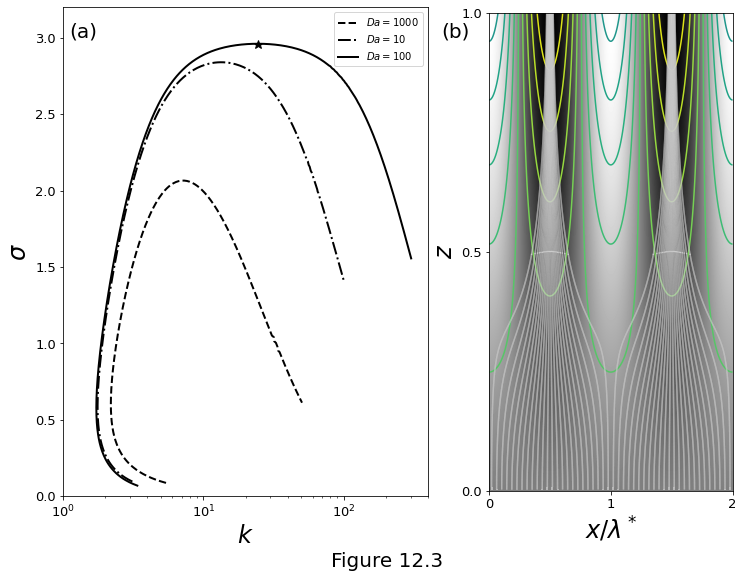
The large-Damköhler number limit¶
Considering the asymptotic limit of large Damköhler number, we can reduce the polynomial \(\eqref{eq:characteristic-poly-cbs}\) to second order,
The function characteristic_polynomial above already includes this case and evaluatees the coefficients of the both characteristic polynomial \(\eqref{eq:characteristic-poly-cbs}\) and \(\eqref{eq:characteristic-poly-quad}\).
Lkbounds = np.log10([0.1, 400.0])
sbounds = np.asarray([0.05, 4.0])
init_Lks = np.asarray([np.log10(5.0), 3.0])
DC_cube = {}
DC_quad = {}
for vals in [10., 100., 1000.]:
par = PAR(Da_=vals, largeDa_=False)
DC_cube[vals] = reactive_flow_trace_dispersion_curve(
par, Lkbounds, sbounds, init_Lks
)
par = PAR(Da_=vals, largeDa_=True)
DC_quad[vals] = reactive_flow_trace_dispersion_curve(
par, Lkbounds, sbounds, init_Lks
)
Figure 12.4 below plots the dispersion curves for growth rate \(\sigma\) as a function of wavenumber \(\wavenumber\). Curves come from numerical solutions to the full problem (cubic polynomial \(\eqref{eq:characteristic-poly-cbs}\), solid lines) and the large-\(\Da\) problem (quadratic \(\eqref{eq:characteristic-poly-quad}\), dashed lines). The agreement for \(\Da \ge 100\) suggests that the large-Damköhler approximation is very good for geologically relevant conditions.
f, ax = plt.subplots()
f.set_size_inches(9., 9.)
for vals, gray in zip([10., 100., 1000.], [0.8, 0.4, 0.]):
plt.plot(
DC_cube[vals].k, DC_cube[vals].s, '-', linewidth=2,
color=[gray, gray, gray], label=r'Da='+str(vals)
)
plt.plot(
DC_quad[vals].k, DC_quad[vals].s, '--', linewidth=2,
color=[gray, gray, gray], label=r'Da=' + str(vals) + ' (large Da)'
)
plt.xscale('log')
plt.xlim(1, 300)
plt.xlabel(r'$k$', fontsize=24)
plt.ylim(0, 3.2)
plt.ylabel(r'$\sigma$', fontsize=24)
plt.legend()
plt.tick_params(axis='both', which='major', labelsize=13)
f.supxlabel("Figure 12.4", fontsize=20)
plt.show()
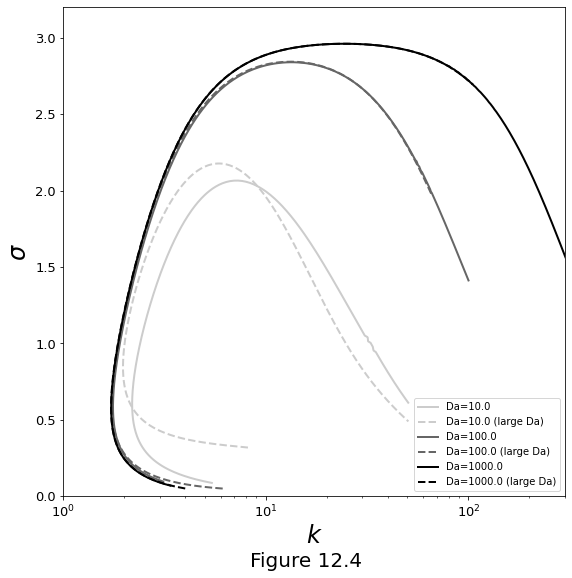
A modified problem and its analytical solution¶
It is possible to obtain an algebraic equation that can be solved for the growth-rate \(\sigma\) as a function of wavenumber \(k\) and parameters \(\permexp,\Da,\Pe,\stiff\) (recall that \(\Kk = 1 + k^2/(\Da\Pe)\)). Without any approximations, the growth rate of \(l=1\) perturbations is given by
The function ReactiveFlowAnalyticalSolution below takes \(k, \permexp,\Da,\Pe,\stiff\) as arguments and evaluates the value of \(\sigma\) given by equation \(\eqref{eq:rxflow-analytical-sigma-full}\).
class PAR_MOD:
def __init__(self):
self.s = None
self.k = None
self.smax = None
self.kmax = None
self.X = None
self.Y = None
self.P = None
self.phi = None
self.U = None
self.W = None
def ReactiveFlowAnalyticalSolution(k, n, Da, Pe, S):
K = (1 + k*k / Da / Pe).astype(np.clongdouble)
b = np.pi
# growth rate - upper branch
full = np.zeros((k.shape[0], 2), dtype=np.clongdouble)
b2 = b ** 2
Da2 = Da ** 2
Da3 = Da ** 3
Da4 = Da ** 4
K2 = K ** 2
K4 = K ** 4
k2 = k ** 2
k4 = k ** 4
k6 = k ** 6
S2 = S ** 2
full[:, 0] = (
2.0 * n * np.sqrt(
-Da4 * K4 * b2 - Da4 * K4 * k2 + Da4 * K2 * S2 * k4
- 3.0 * Da3 * K2 * S * k4 - 2 * Da2 * K2 * b2 * k2
- Da * S * k6 - b2 * k4
)
+ 4 * Da * K * b2 * n + Da * K * k2 * n
+ 2 * Da2 * K * S * k2 * n
) / (
4 * S * Da2 * K2 * b2 + 4 * S * Da2 * K2 * k2 + S * k4
)
# lower branch
full[:, 1] = -(
2.0 * n * np.sqrt(
- Da4 * K4 * b2 - Da4 * K4 * k2
+ Da4 * K2 * S2 * k4 - 3 * Da3 * K2 * S * k4
- 2 * Da2 * K2 * b2 * k2 - Da * S * k6 - b2 * k4
)
- K * (4 * Da * n * b2 + n * (2 * S * Da2 + Da) * k2)
) / (
S * (4 * Da2 * K2 * b2 + 4 * Da2 * K2 * k2 + k4)
)
real1 = np.nonzero(
np.imag(full[:, 0]).astype(np.float32) == 0.0
)
real2 = np.nonzero(
np.imag(full[:, 1]).astype(np.float32) == 0.0
)
s = PAR_MOD()
s.s = np.real(
np.concatenate((
np.flipud(full[real1, 0].flatten()),
full[real2, 1].flatten()
))
)
s.k = np.real(
np.concatenate((
np.flipud(k[real1].flatten()), k[real2].flatten()
))
)
I = np.argmax(s.s)
s.smax = s.s[I]
s.kmax = s.k[I]
# eigenfunctions
K = 1 + s.kmax ** 2 / Da / Pe
a = 0.5 * (
n * K / S + s.smax * s.kmax ** 2 / Da
) / (
s.smax * K - n / Da / S
)
m = a + 1j * np.pi
lambda_ = 2 * np.pi / s.kmax
x = np.linspace(0, 2 * lambda_, 1000)
hx = x[2]-x[1]
y = np.linspace(0, 1, 1000)
hy = y[2]-y[1]
s.X, s.Y = np.meshgrid(x, y)
s.P = np.exp(a * s.Y) * np.sin(np.pi * s.Y) * np.sin(s.kmax * s.X)
tmp = np.exp(a * s.Y) * np.cos(np.pi * s.Y) * np.sin(s.kmax * s.X)
dphi_dy = S * (
(a ** 2 - np.pi ** 2 - s.kmax ** 2) * s.P + 2 * a * np.pi * tmp
) / n
s.phi = np.cumsum(dphi_dy, axis=0) * hy
Py, Px = np.gradient(s.P, hy, hx)
s.U = -S * Px
s.W = (n - 1) * s.phi - S * Py
s.P = (s.P - np.amin(s.P)) / (np.amax(s.P) - np.amin(s.P))
s.phi = (s.phi - np.amin(s.phi)) / (np.amax(s.phi) - np.amin(s.phi))
return s
n = 3.
Da = 1000.
Pe = 100.
S = np.asarray([0.01, 0.1, 1, 10]).astype(np.clongdouble)
k = np.logspace(-1.0, 4.0, 10000).astype(np.clongdouble)
s = []
for s_ in S:
s.append(ReactiveFlowAnalyticalSolution(k, n, Da, Pe, s_))
Figure 12.5 below plot the results for the modified problem with \(\cmppres\first=0\) at \(z=1\). (a) Dispersion curves for \(n=3\), \(\Da=1000\), \(\Pe=100\) and four values of \(\stiff\). Maximum values of the growth rate for each curve are marked by stars. The eigenfunctions for each of these maxima are plotted in subsequent panels. (b) The \(\cmppres\first\) eigenfunction for \(\stiff=1\). White curves are streamlines of the flow \(\vel\liq = \zhat + \smallpar\vel\first\), with \(\smallpar\) chosen to be \(3\times10^{-3}\). (c) \(\cmppres\first\) for \(\stiff=0.1\) with superimposed contours of the porosity perturbation \(\por\first\). Porosity is larger in the low-pressure channels. (d) \(\cmppres\first\) for \(\stiff=0.01\).
fig = plt.figure(figsize=(18., 9.))
gs = gridspec.GridSpec(1, 4, width_ratios=[6, 3, 2, 1])
ax0 = plt.subplot(gs[0])
for s_, lstyi, S_ in zip(s, {'--k', '-k', '-.k', ':k'}, S):
ax0.semilogx(
s_.k, s_.s, lstyi, linewidth=2,
label=r'$\mathcal{S}=' + str(np.real(S_).astype(np.float32)) + '$'
)
ax0.plot(
s_.kmax, s_.smax, '*k', linewidth=1, markersize=10
)
ax0.set_xlabel(r'$k$', fontsize=24)
ax0.set_xlim(0.5, 8000)
ax0.set_xticks(ticks=(1.e0, 1.e1, 1.e2, 1.e3))
ax0.set_ylabel(r'$\sigma$', fontsize=24)
ax0.set_ylim(0.0, 3.0)
ax0.legend(fontsize=16)
ax0.tick_params(axis='both', which='major', labelsize=13)
ax0.text(
0.5e4, 0.05, '(a)', fontsize=16,
verticalalignment='bottom', horizontalalignment='right'
)
AR = 2 * np.pi / np.asarray([s[2].kmax, s[1].kmax, s[0].kmax])
ax1 = plt.subplot(gs[1])
lambda_ = np.float32(AR[0])
ax1 = plt.subplot(gs[1])
ax1.imshow(
np.real(s[2].P).astype(np.float32), cmap='gray',
extent=[0.0, 2.*lambda_, 0.0, 1.0]
)
ax1.set_ylabel(r'$y$', fontsize=24)
nlines = 48
h = 2 * lambda_ / (nlines + 1)
seed = np.zeros((nlines, 2))
seed[:, 0] = np.linspace(0.5 * h, 2.0 * lambda_ - 0.5 * h, nlines)
seed[:, 1] = 0.001
epsilon = 3e-3
U = epsilon * np.real(s[2].U).astype(np.float64)
W = 1. + epsilon * np.real(s[2].W).astype(np.float64)
x = np.linspace(0., 2. * lambda_, 1000)
y = np.linspace(0., 1., 1000)
X, Y = np.meshgrid(x, y)
ax1.streamplot(
X, Y, U, W, start_points=seed,
integration_direction='forward', density=(90, 60),
color=[0.8, 0.8, 0.8], arrowstyle='-'
)
ax1.set_xticks((0, AR[0], 2*AR[0]))
ax1.set_xticklabels((0, 1, 2))
ax1.tick_params(axis='both', which='major', labelsize=13)
ax1.text(
-0.01, 0.01, '(b)', fontsize=18,
verticalalignment='bottom', horizontalalignment='right'
)
ax2 = plt.subplot(gs[2])
lambda_ = np.float32(AR[1])
ax2 = plt.subplot(gs[2])
ax2.imshow(
np.flipud(np.real(s[1].P)).astype(np.float32), cmap='gray',
extent=[0.0, 2.*lambda_, 0.0, 1.0]
)
x = np.linspace(0, 2 * lambda_, 1000)
y = np.linspace(0, 1, 1000)
X, Y = np.meshgrid(x, y)
ax2.contour(
X, Y, np.real(s[1].phi).astype(np.float32),
levels=np.linspace(0, 1, 12)
)
ax2.set_xticks((0, lambda_, 2*lambda_))
ax2.set_xticklabels((0, 1, 2))
ax2.set_yticklabels(())
ax2.set_xlabel(r'$x/\lambda^*$', fontsize=24)
ax2.tick_params(axis='both', which='major', labelsize=13)
ax2.text(
-0.01, 0.01, r'(c)', fontsize=18,
verticalalignment='bottom', horizontalalignment='right'
)
ax3 = plt.subplot(gs[3])
lambda_ = np.float32(AR[2])
ax3.imshow(
np.flipud(np.real(s[0].P)).astype(np.float32),
cmap='gray', extent=[0.0, 2.*lambda_, 0.0, 1.0]
)
ax3.set_xticks((0, 2*lambda_))
ax3.set_xticklabels((0., 2.))
ax3.set_yticklabels(())
plt.text(
-0.02, 0.01, r'(d)', fontsize=18,
verticalalignment='bottom', horizontalalignment='right'
)
ax3.tick_params(axis='both', which='major', labelsize=13)
fig.supxlabel("Figure 12.5", fontsize=20)
plt.show()
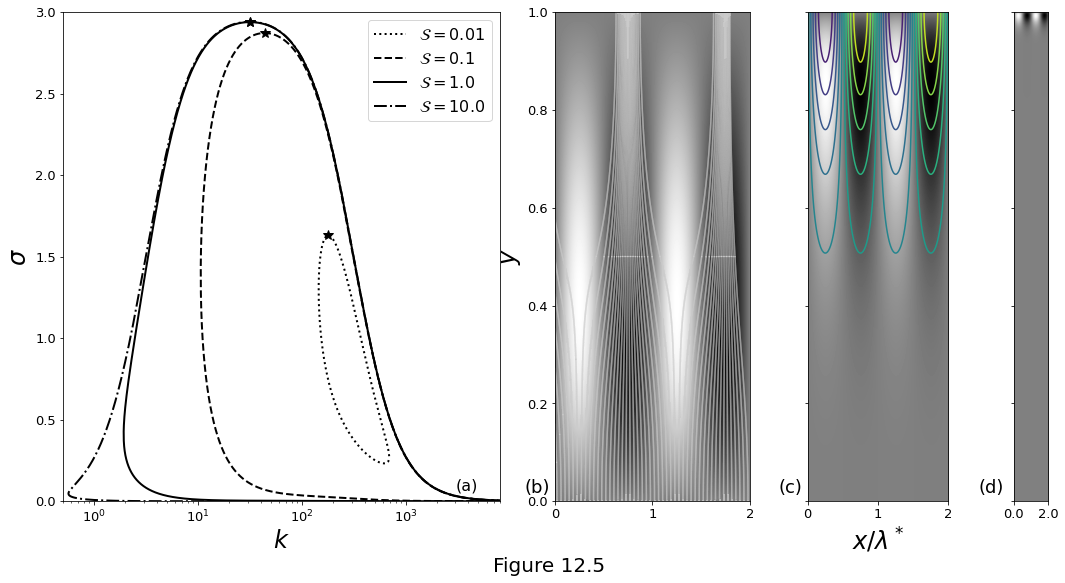
Equation \(\eqref{eq:rxflow-analytical-sigma-full}\) is exact but difficult to analyse. We therefore design an approximation to be valid only near the peak growth rate:
and substitute, dropping the \(\permexp/\Da\stiff\) terms. We find that
Here we have made the additional approximation that near the maximum growth rate (i.e., for \(\wavenumber\approx\wavenumber^*\) at which \(\epsilon \ll 1\)), \(\wavenumber^2/\Da\Pe \ll 1\) and hence that \(\Kk \sim 1\).
The maximum growth rate \(\sigma\sim\sigma^*\) occurs where \(\epsilon\) is at a minimum with respect to \(\wavenumber\). Using equations \(\eqref{eq:rxflow-analytic-real-im-asymptotic_a}\) - \(\eqref{eq:rxflow-analytic-real-im-asymptotic_e}\) we find that
where \(\mathcal{B} \equiv b^2 + (2\stiff)^{-2}\). The maximum growth rate \(\sigma^*\) of the channel instability is
class SA_Growth():
def __init__(self):
self.k = None
self.a = None
self.e = None
self.s = None
def asym_maxgrowth(k, n, Da, Pe, S, l):
b = l * np.pi
B = b**2 + 1.0/4.0/S**2
s_ = SA_Growth()
k = np.power(4.0*Da*Pe*(b**2 + 1.0/4.0/S**2)/(4.0 + Pe/Da), 0.25)
a = 1.0/2.0/S + k**2.0/2.0/Da
e = (a**2 + b**2)/k**2 + k**2/Da/Pe
s = n * (1.0 - 1.0/Da/2.0/S - 2.0*np.sqrt(B*(1.0/Da/Pe + 1.0/4.0/Da**2)))
s_.k = np.real(k).astype(np.float32)
s_.a = np.real(a).astype(np.float32)
s_.e = np.real(e).astype(np.float32)
s_.s = np.real(s).astype(np.float32)
return s_
class SA_Dispersion():
def __init__(self):
self.s = None
self.k = None
def asym_dispersion(k, n, Da, Pe, S, l):
a = 1/2/S + k**2/2/Da
b = l * np.pi
epsilon = (a**2 + b**2)/k**2 + k**2/Da/Pe
s = n*(1-epsilon)
s[np.imag(s) != 0.0] = np.nan
return np.real(s).astype(np.float32)
def full_dispersion(k, n, Da, Pe, S, l):
b = np.clongdouble(l * np.pi)
b2 = b ** 2
k2 = k**2
k4 = k2 * k2
k6 = k2 * k4
Da = np.clongdouble(Da)
Da2 = Da ** 2
Da3 = Da * Da2
Da4 = Da2 * Da2
K = 1.0 + k2 / Da / np.clongdouble(Pe)
K2 = K ** 2
K4 = K2 * K2
S2 = np.clongdouble(S ** 2)
# upper branch
su = (
2.0 * n * np.sqrt(
-Da4 * K4 * b2 - Da4 * K4 * k2
+ Da4 * K2 * S2 * k4 - 3.0 * Da3 * K2 * S * k4
- 2.0 * Da2 * K2 * b2 * k2 - Da * S * k6 - b2 * k4
)
+ 4.0 * Da * K * b2 * n
+ Da * K * k2 * n + 2.0 * Da2 * K * S * k2 * n
) / (
4.0 * S * Da2 * K2 * b2 + 4.0 * S * Da2 * K2 * k2 + S * k4
)
iu = np.imag(su) == 0.0
# lower branch
sl = -(
2.0 * n * np.sqrt(
-Da4 * K4 * b2 - Da4 * K4 * k2
+ Da4 * K2 * S2 * k4 - 3.0 * Da3 * K2 * S * k4
- 2.0 * Da2 * K2 * b2 * k2 - Da*S*k6 - b2 * k4
)
- K * (4 * Da * n * b2
+ n * (2.0 * S * Da2 + Da) * k2)
) / (
S * (4 * Da2 * K2 * b2 + 4.0 * Da2 * K2 * k2 + k4)
)
il = np.imag(sl) == 0
s = SA_Dispersion()
s.s = np.hstack([
np.flip(np.real(su[iu]).astype(np.float32)),
np.real(sl[il]).astype(np.float32)
])
s.k = np.hstack([
np.flip(np.real(k[iu]).astype(np.float32)),
np.real(k[il]).astype(np.float32)
])
return s
Properties of the dispersion curve near its maximum, with \(n=3,\,\Da=10^4,\,b=\pi\). (a) Comparison of the exact dispersion relation \(\eqref{eq:rxflow-analytical-sigma-full}\) (solid lines) with the asymptotic relations \(\eqref{eq:rxflow-asymptotic-sigma}\)-\(\eqref{eq:rxflow-analytic-real-im-asymptotic_e}\) (dashed lines) for \(\Pe/\Da=10^{-2}\) and two values of \(\stiff\), as given in the legend. (b) Contours of fastest-growing (non-dimensional) wavelength \(\lambda^*\) for a range of \(\stiff\) and \(\Pe\) from equation \(\eqref{eq:rxflow-kstar-full}\). Dotted lines are at \(\Pe/\Da = 4\) and \(\stiff = 1/2\pi\). In both panels, stars indicate the maximum (\(\wavenumber^*,\sigma^*\)) of the asymptotic curves, computed with \(\eqref{eq:rxflow-kstar-full}\) and \(\eqref{eq:rxflow-sstar-full}\).
fig = plt.figure(figsize=(12., 9.))
gs = gridspec.GridSpec(1, 2, width_ratios=[1, 1])
ax0 = plt.subplot(gs[0])
Da = 1e4
k = np.logspace(-1, 4, 10000).astype(np.clongdouble)
n = 3
Pe = Da / 100
S = np.asarray([1.0, 0.01]).astype(np.clongdouble)
l = 1.0
sfull = full_dispersion(k, n, Da, Pe, S[0], l)
sasym = asym_dispersion(k, n, Da, Pe, S[0], l)
smax = asym_maxgrowth(k, n, Da, Pe, S[0], l)
ax0.loglog(
sfull.k, sfull.s, '-', linewidth=2,
color=[0.5, 0.5, 0.5], label=r'$\mathcal{S}='+str(np.real(S[0]))+'$'
)
ax0.loglog(
np.real(k), sasym, '--',
linewidth=0.5, color=[0.5, 0.5, 0.5]
)
ax0.plot(
smax.k, smax.s, '*', markersize=7,
color=[0.5, 0.5, 0.5]
)
sfull = full_dispersion(k, n, Da, Pe, S[1], l)
sasym = asym_dispersion(k, n, Da, Pe, S[1], l)
smax = asym_maxgrowth(k, n, Da, Pe, S[1], l)
ax0.loglog(
sfull.k, sfull.s, '-k', linewidth=2,
label=r'$\mathcal{S}='+str(np.real(S[0]))+'$'
)
ax0.loglog(np.real(k), sasym, '--k', linewidth=0.5)
ax0.plot(smax.k, smax.s, '*k', markersize=7)
ax0.plot(
np.real([k[0], k[-1]]), [n, n], ':k', label=r'$\sigma=n$'
)
ax0.set_xlim(np.sqrt(0.1), np.power(10, 3.5))
ax0.set_xticks([1.e0, 1.e1, 1.e2, 1.e3])
ax0.set_xlabel(r'$k$', fontsize=20)
ax0.set_ylabel(r'$\sigma$', fontsize=20)
ax0.set_ylim(1.0, 3.1)
ax0.set_yscale('linear')
ax0.set_yticks([1, 2, 3])
ax0.tick_params(axis='both', which='major', labelsize=13)
ax0.text(
0.4, 1.1, r'(a)', fontsize=16,
verticalalignment='bottom', horizontalalignment='left'
)
ax0.legend(
fontsize=15, loc='upper left',
bbox_to_anchor=(0.06, 1.09), ncol=3
)
ax1 = plt.subplot(gs[1])
Spts = S
Pe_Da = Pe / Da
Pe = np.logspace(np.log10(Da) - 4.0, np.log10(Da) + 4, 100)
S = np.logspace(-3.0, 1.0, 100)
X, Y = np.meshgrid(Pe, S)
B = np.pi ** 2 + 1. / (2 * Y) ** 2
Ks = np.power(4 * Da * X * B / (4 + X / Da), 0.25)
lambda_ = 2 * np.pi / Ks
ax1.contour(Pe / Da, S, np.log10(lambda_), 16, cmap='gray')
ax1.plot([Pe[0]/Da, Pe[-1]/Da], [1/2/np.pi, 1/2/np.pi], ':k')
ax1.plot([4, 4], [S[1], S[-1]], ':k')
ax1.plot(Pe_Da, np.real(Spts[0]), '*', markersize=7, color=[0.5, 0.5, 0.5])
ax1.plot(Pe_Da, np.real(Spts[1]), '*k', markersize=7)
ax1.set_xscale('log')
ax1.set_yscale('log')
ax1.set_xticks((1.e-4, 1.e-2, 1.e0, 1.e2, 1.e4))
ax1.set_yticks((1.e-2, 1.e0))
ax1.set_ylabel(r'$\mathcal{S}$', fontsize=20)
ax1.set_xlabel(r'Pe$/$Da', fontsize=20)
ax1.tick_params(axis='both', which='major', labelsize=13)
ax1.text(
0.0002, 0.002, r'(b)', fontsize=20, verticalalignment='bottom',
horizontalalignment='left', backgroundcolor='w'
)
ax1.text(
1.4e4, 0.02, r'$\leftarrow$rigid compactible$\rightarrow$',
rotation=-90, horizontalalignment='center',
verticalalignment='bottom', fontsize=15
)
ax1.text(
0.58, 11, r'$\leftarrow$diffusion ctrl advection ctrl$\rightarrow$',
horizontalalignment='center', verticalalignment='bottom', fontsize=15
)
fig.supxlabel("Figure 12.6", fontsize=20)
plt.show()
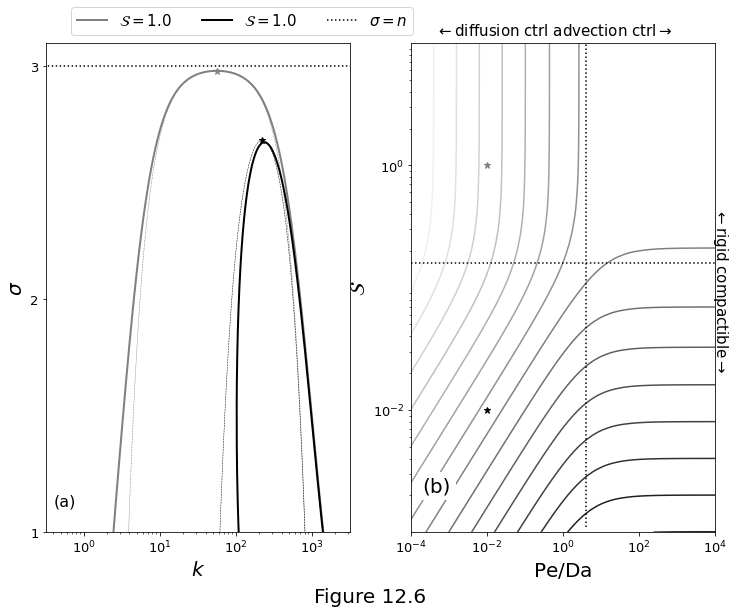
Application to the mantle¶
Parameters and their values (and ranges) for application to the mantle beneath mid-ocean ridges:
Variable (unit) |
Symbol |
Estimate (range) |
|---|---|---|
Permeability exponent |
\(\permexp\) |
\(3\) \((2-3)\) |
Solubility gradient (m\(^{-1}\)) |
\(\beta\) |
\(2\times10^{-6}\) (\(10^{-6}-4\times10^{-6}\)) |
Compositional offset |
\(\alpha\) |
\(1\) |
Melting region depth (m) |
\(H\) |
\(8\times10^{4}\) |
Compaction length (m) |
\(\cmplength\) |
\(10^{3}\) (\(3\times10^2-10^4\)) |
Melt flux (m s\(^{-1}\)) |
\(\por_0 w_0\) |
\(3\times10^{-11}\) (\(5\times10^{-12}-2\times10^{-10}\)) |
Diffusivity (m\(^2\)s\(^{-1}\)) |
\(\por_0 \chemdiffuse\) |
\(3\times10^{-14}\) (\(10^{-15}-10^{-12}\)) |
Reaction rate (s\(^{-1}\)) |
\(\rxnrate\) |
\(3\times10^{-8}\) (\(10^{-11}-10^{-4}\)) |
Decompression melting rate (s\(^{-1}\)) |
\(W_0\adiprod\) |
\(3\times10^{-15}\) (\(10^{-15} - 10^{-14}\)) |
Melt productivity~ratio |
\(\dpro\) |
\(45\) (\(1-200\)) |
Reactive melt volume |
\(\rpro\) |
\(0.14\) (\(0.07-0.28\)) |
Peclet number |
\(\Pe\) |
\(7\times10^9\) (\(3.5\times10^7 - 1.4\times10^{12}\)) |
Damköhler number |
\(\Da\) |
\(7 \times 10^7\) (\(3.5\times10^3 - 1.4\times10^{12}\)) |
Stiffness number |
\(\stiff\) |
\(3\times10^{-5}\) (\(1\times10^{-6} - 6\times10^{-3}\)) |
class PAR:
def __init__(self):
self.n = 3 # permeability exponent
self.S = 3e-5 # rigidity parameter
self.Da = 7e7 # Damkohler number
self.Pe = 7e9 # Peclet number
self.H = 8e4 # column height, metres
self.tscale = 1 * 0.01 / 3e-11 / 2e-6 / (np.pi * 1e7) # years
def Dispersion(k, n, Da, Pe, S):
k = k.astype(np.clongdouble)
k2 = k * k
k4 = k2 * k2
k6 = k4 * k2
n, Da, Pe, S = np.clongdouble([n, Da, Pe, S])
K = 1 + k ** 2 / Da / Pe
K2 = K * K
K4 = K2 * K2
Da2 = Da * Da
Da3 = Da2 * Da
Da4 = Da2 * Da2
b = np.clongdouble(np.pi)
b2 = b * b
S2 = S * S
# upper branch
s = (2.0 * n * \
np.sqrt(
-Da4 * K4 * b2 - Da4 * K4 * k2
+ Da4 * K2 * S2 * k4 - 3.0 * Da3 * K2 * S * k4
- 2 * Da2 * K2 * b2 * k2 - Da * S * k6 - b2 * k4
)
+ 4.0 * Da * K * b2 * n + Da * K * k2 * n
+ 2 * Da2 * K * S * k2 * n
) / (
4 * S * Da2 * K2 * b2 + 4.0 * S * Da2 * K2 * k2 + S * k4
)
s[np.imag(s) != 0.0] = np.nan
return np.real(s).astype(np.float32)
Figure below plots the time-scale of channel growth \(1/\sigma\) as a function of the horizontal wavelength of channels. This curve is computed using the full dispersion relation \(\eqref{eq:rxflow-analytical-sigma-full}\) with preferred parameter values from table above. Horizontal dotted lines mark the minimum growth time (\(\sigma=1/\permexp\), in non-dimensional terms) and this value plus 2%.
fig = plt.figure(figsize=(9., 9.))
par = PAR()
k = np.logspace(4, 8, 10000)
s = Dispersion(k, par.n, par.Da, par.Pe, par.S)
lambda_ = (2 * np.pi / k) * par.H # metres
tau = (1. / s) * par.tscale / 1e6 # million years
tau_ref = (1. / par.n) * par.tscale / 1e6 # million years
tau_ref90 = (1.02 / par.n) * par.tscale / 1e6 # million years
plt.semilogx(lambda_, tau, '-k', linewidth=2)
plt.plot([1e-5, 1e5], [tau_ref, tau_ref], ':k')
plt.plot([1e-5, 1e5], [tau_ref90, tau_ref90], ':k')
plt.xlim(1e-3, 1e2)
plt.ylim(1.5, 2.5)
plt.xticks((1e-2, 1e0, 1e2))
plt.yticks((1.5, 2.0, 2.5))
plt.xlabel('Horizontal wavelength, m', fontsize=18)
plt.ylabel('Growth time, Ma', fontsize=18)
plt.tick_params(axis='both', which='major', labelsize=13)
fig.supxlabel("Figure 12.7", fontsize=20)
plt.show()
